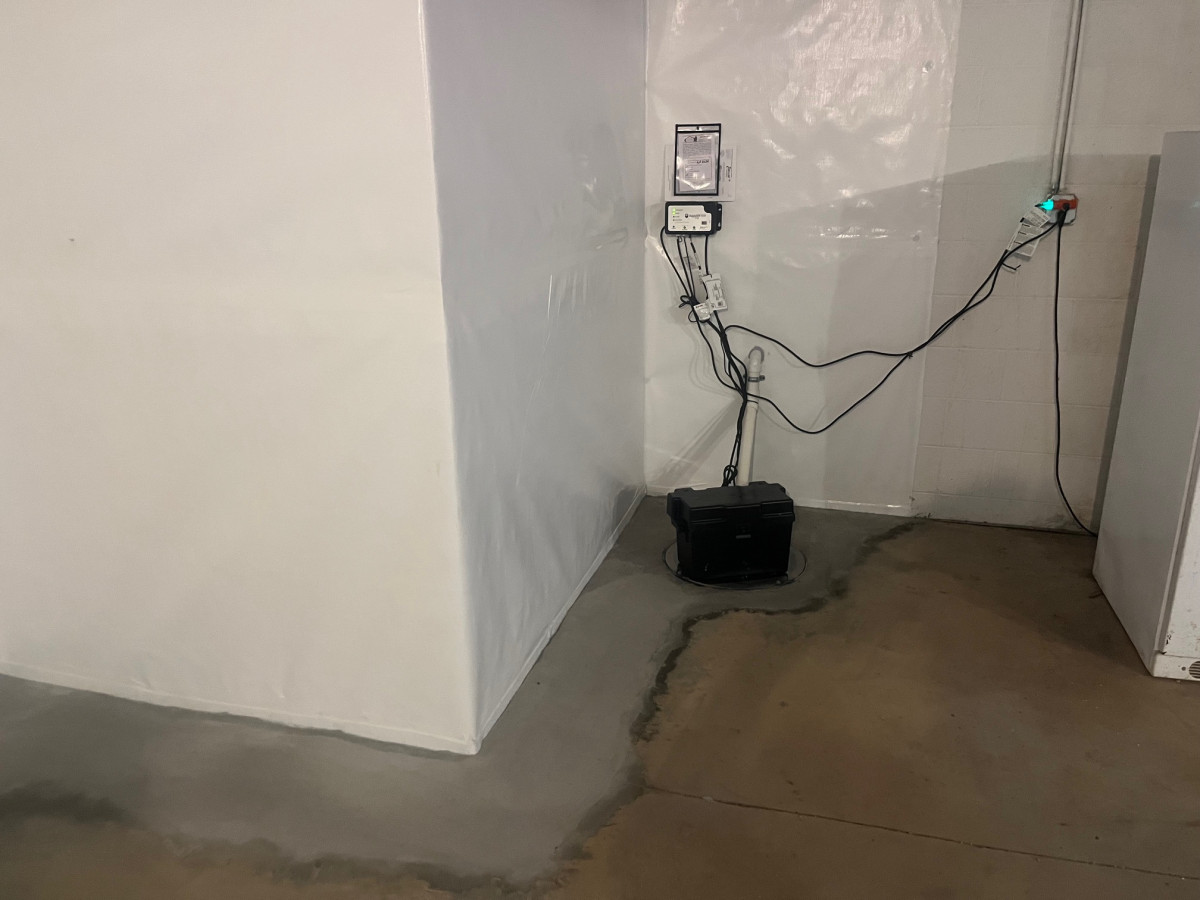How to Respond to a Flooded Basement: Safety, Water Removal, Repairs, and Prevention Tips
Hendersonville, United States - April 18, 2025 / Basement & Radon Solutions /
Imagine waking up to find your basement transformed into an indoor pool. Not the best way to start the day, is it? Don’t worry, you’re not alone and there are steps you can take to tackle this unexpected situation. First, you’ll need to identify the source of the water – it could be a leaky pipe, a faulty sump pump, or even an exterior drainage issue. But what’s the next step after that? And how can you prevent this from happening again? Let’s explore these questions further, shall we?
Assess the Situation Safely
What’s the first thing you should do when you discover water in your basement? Don’t panic. It’s crucial that you approach this situation calmly and safely.
Before you start dealing with the water, verify you’re protected. You don’t know what’s in that water; it could be contaminated with bacteria or other hazards.
Wear rubber gloves, boots, and protective clothing. If the water level is high, avoid entering the basement until the water level has been reduced. Electrical appliances submerged or even partially covered by water can pose a serious electrocution risk.
If you can safely reach the breaker without wading through water, go ahead and shut off the basement’s power. If not, call a professional electrician immediately.
Once you’re safe, take a look around. How much water is there? Is it covering the whole basement or just a corner? Is it clear or murky?
These observations will be useful when it’s time to clean up and figure out what caused the problem. Remember, safety first. It’s not worth risking your health or life over a flooded basement.
Identify the Water Source
Pinpointing the source of the water is your next step. It’s not just about mopping up; understanding where the water is coming from will help you prevent future occurrences. There are several potential sources.
Check first for leaks in your home’s interior pipes. In the basement, look for signs of dripping or water stains on the walls or ceiling. If you can’t find any visible leaks, it might be a hidden one behind a wall or beneath the floor.
Examine the exterior of your home as well. Water in the basement often comes from rainwater or melted snow seeping in from the outside. Look for poorly positioned downspouts or landscape grading that slopes towards your house.
If it’s been raining, inspect your gutters. A clog could be causing water to overflow and saturate the ground around your foundation.
Don’t forget to take into account the possibility of a sewer backup or sump pump failure. Both can lead to water in your basement and require professional intervention.
Once you’ve identified the water source, you’re better equipped to tackle the problem effectively and efficiently. It’s an essential step in handling any basement water issue.
Start the Water Removal Process
Now that you’ve identified the source of the water, it’s time to start the removal process.
The first step is effective water extraction, which you’ll need to handle carefully to prevent further damage.
Once the water is removed, the next critical step is drying and dehumidifying the area to prevent mold growth and residual dampness.
Identify Water Source
Before you can start the water removal process in your basement, it’s vital to first identify the source of the water. Remember, water can come from various origins like rainwater seepage, broken pipes, or even a faulty sump pump.
Start by examining the walls and floor of your basement. If you notice water trickling down from the walls, it’s likely a sign of external water seepage. Look for cracks or damp spots on the wall.
Meanwhile, if the water seems to be coming from a specific area in the floor or there’s a sudden pool of water, there could be an internal issue, such as a burst pipe.
Don’t forget to inspect your sump pump, if you have one. If it’s not working correctly, it could be the culprit.
Also, examine the gutters and downspouts outside your home. If they’re blocked or not properly directing water away, rainwater could easily find its way into your basement.
Identifying the source of the water is key, as it’s not only about removing the water but preventing future occurrences. This proactive approach saves you time, money, and the hassle of repeated water damage.
Effective Water Extraction
Once you’ve identified the source of the water, it’s important to promptly begin the water extraction process. This procedure is vital for minimizing damage and preventing mold growth.
You’ll need to equip yourself with the right tools, such as a wet vacuum or a sump pump, depending on the severity of the flooding. A wet vacuum is perfect for smaller quantities of water, whereas a sump pump is ideal for larger-scale water issues. If the flooding is extreme, you may need to hire a professional water extraction service.
Don’t forget to wear protective gear during the extraction process. This includes gloves, waterproof boots, and potentially a mask if the water is contaminated.
Next, start from the lowest point in your basement and work your way up. Make sure to thoroughly vacuum or pump all areas so no water is left behind.
Throughout the extraction process, it’s important to avoid using electricity in the basement to prevent accidents. Always remember to disconnect all electrical appliances before starting the process.
Drying and Dehumidifying
After the water extraction process is complete, the next step to contemplate is drying and dehumidifying your basement.
It’s crucial to understand that drying out the area promptly is critical to prevent the growth of mold and mildew, which thrive in damp conditions.
Start by opening windows and doors to promote airflow, if weather permits.
Use fans and heaters to speed up the drying process.
Remember, the goal is to get as much air circulating as possible.
Next, consider bringing in a dehumidifier to pull moisture out of the air.
This appliance is incredibly efficient at reducing humidity levels, which aids in drying out your basement faster.
It’s worth noting that dehumidifiers are particularly effective in enclosed spaces, where the airflow is often limited.
Monitor the progress and remember, drying usually takes a few days to a week, depending on the severity of the water intrusion.
If you’re dealing with a substantial amount of water damage, you may need to call in a professional to guarantee a thorough job.
Taking quick action and following these steps can save you a lot of trouble down the line.
Dry and Dehumidify the Area
Maneuvering through a water-logged basement can be overwhelming, but drying and dehumidifying the area is an essential first step.
After you’ve stopped the water source and removed any standing water, you’ll need to focus on drying out the area as quickly as possible. The sooner you start, the less chance there’s for mold and mildew to form.
A wet/dry vacuum can be a helpful tool for removing any remaining water from your floors.
Simultaneously, use fans and dehumidifiers to help speed up the drying process. Place fans at a doorway or window to vent the humid air outside instead of spreading it around. Dehumidifiers can be particularly effective in enclosed areas, like your basement, where the air is often damp.
For hard-to-dry items like furniture and rugs, consider professional cleaning services. They’ve the right equipment to dry your belongings without causing further damage.
Remember, you’re not only drying your basement to clear the mess, but you’re also preventing potential health hazards.
Last, keep an eye on the humidity levels. A hygrometer, which measures humidity, can be a handy tool.
Ideally, you should aim for a humidity level of 50% or less to prevent mold growth.
Repair and Restoration Steps
Now that you’ve dried and dehumidified your basement, it’s time to tackle the repair and restoration process.
First, you’ll need to know how to identify any residual water damage.
Then, we’ll guide you through essential repair procedures and post-restoration precautions to guarantee your basement remains dry and damage-free.
Identifying Water Damage
Identifying water damage in your basement is the first essential step in the repair and restoration process. It’s vital to pinpoint the signs early on to prevent further damage.
Start by checking for visible signs of water seepage, such as damp or discolored spots on the walls and floor. Pay close attention to corners and areas near pipes as these are common sites for leakage.
Sometimes, water damage isn’t always visible. You might notice a musty smell, indicating the presence of mold or mildew, both of which thrive in damp conditions.
Another sign of water damage is efflorescence, a chalky white substance that forms on concrete when water evaporates from the surface. If you notice this, it’s a clear sign water has been present.
Inspect your basement regularly, especially after heavy rainfall or when you’ve noticed higher than usual humidity levels.
In the case of severe flooding, water lines on the walls clearly indicate water damage.
Essential Repair Procedures
Dealing with water damage involves a step-by-step approach to guarantee effective and lasting repairs.
First, you’ll need to remove all the water. This can be done using a sump pump or a wet/dry vacuum. You must then dry out the area thoroughly. Dehumidifiers and fans can be very effective for this.
Next, you’ll need to clean and sanitize the area. This step is essential as basements are prone to mold and mildew growth. Use a strong, non-toxic cleaner to verify all surfaces are free from contaminants.
Then, it’s time for repair and restoration. This might involve replacing damaged drywall or flooring, and repainting walls. If you’re not comfortable doing this yourself, consider hiring a professional.
Lastly, you’ll need to take steps to prevent future flooding. This might involve improving your home’s drainage system, installing a sump pump, or waterproofing your basement walls.
Post-Restoration Precautions
Once the repair and restoration phase is complete, it’s vital to focus on post-restoration precautions. It’s not enough to repair the damage; you need to take steps to prevent future incidents.
Firstly, check for any residual dampness. It’s essential to verify all moisture has been thoroughly dried up to prevent mold growth, which can lead to health issues. Use a dehumidifier if necessary.
Next, assess the structural integrity of your basement. If water damage has weakened the foundation, consider hiring a professional to reinforce it.
Also, inspect your sump pump regularly to confirm it’s functioning properly. If it’s not, you’re at risk for another flood.
Remember to clean your gutters and downspouts too. Blocked gutters can lead to water accumulation around your foundation, potentially causing leaks.
Lastly, review your home insurance policy. Some policies don’t cover basement flooding, so it’s worthwhile to explore additional coverage options.
Preventing Future Basement Flooding
To safeguard your home from the distressing problem of basement flooding, it’s essential to put preventive measures in place.
First, consider your home’s landscaping. Make sure the ground around your house slopes away from your foundation. This guarantees rainwater doesn’t pool around your home, leading to seepage into your basement.
Next, maintain your gutters and downspouts. Clear them of debris regularly to allow for proper water flow. Extend your downspouts so water is directed away from your home, ideally three feet or more.
Another effective solution is to install a sump pump. It collects excess water and moves it away from your house. To make sure it’s always ready for a sudden deluge, test it periodically and keep it maintained.
Finally, think about waterproofing your basement. This might involve applying a sealant on the interior of your basement walls or installing a French drain system to redirect water.
Preventing basement flooding isn’t just about avoiding the inconvenience of a wet basement. It’s also about protecting your home’s structural integrity and your family’s health.
With these steps, you’re actively steering clear of potential mold problems and structural damages.
Remember, a flooded basement isn’t just inconvenient – it’s a potential hazard. According to the National Flood Insurance Program, floods cause over $3 billion in claims annually. It’s essential to act swiftly, safely remove water, thoroughly dry and dehumidify the area, and take preventive measures. By being prepared and proactive, you’re not just protecting your property, but your peace of mind too. Stay vigilant and remember, safety first.

Contact Information:
Basement & Radon Solutions
1548 Airport Rd Unit B1
Hendersonville, NC 28792
United States
Basement & Radon Solutions
(828) 697-2075
https://basementandradonsolutions.com/
Original Source: https://basementandradonsolutions.com/media-room/


